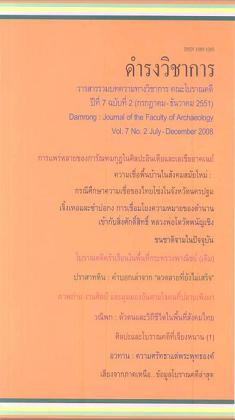KARANDAMAKUTA IN INDIAN AND SOUTHEAST INDIAN ART
Keywords:
ศิลปะอินเดีย, การัณฑมกุฎ, ศิลปะเอเชียอาคเนย์Abstract
A Karandamakuta is a type of crown with an imposing and inverted-pot shape. Originating from India, during the Pallava period, there purpose is to portray minor deities, in an iconographical illustration. The Karandamakuta are visible in the Chola sculptures, throughout South India, as well as influencing Pala art in Northern India.
Karandamakutas are also seen in Sri Lankan, Tibetan and Pagan art, with only slight differences between the Northern and Southern styles. Within Thailand Karadamakutas are often present upon statues of the Sukhothai and Ayuthaya regions, displaying a mixture of the northern and Southern styles.
References
Bautze-Picron, C. The Buddhist Murals of Pagan : Timeless Vistas of the Cosmos. Bangkok : Orchid Press, 2003.
Huntington, S.L. The Art of Ancient India: Buddhist Hindu Jain. New York : Weatherhill, 1999.
Huntington, S.L. Pala-Sena Schools of Sculpture. Leiden : E.J.Brill, 1984.
Kossak, S.T. and Singer, J.C. Sacred Version : Early Painting from Central Tibet. New York : The Metropolitan Museum of Art, 1999.
Majumdar, R.C. "The Struggle for Empire". The History and Culture of The Indian People, Vol. 5 (Mumbai : Bhartiya Vidya Bhavan, 2001).
Schroeder, U.V. The Golden Age of Sculpture in Sri Lanka : Masterpleces of
Buddhist and Hindu Bronzes from Museums in Sri Lanka. Hong Kong : Visual Dharma Publications, 1992.
Stutley, M. The Ilustrated Dictoinary of Hindu Iconography. London : Routledge & Kegan Paul, 1985.
สันติ เล็กสุขุม, ศิลปะสุโขทัย. กรุงเทพ : เมืองโบราณ, 2540.
Downloads
Issue
Section
License
บทความนี้เป็นผลงานของข้าพเจ้าแต่เพียงผู้เดียว และ/หรือเป็นผลงานของข้าพเจ้าและผู้ร่วมงาน ตามชื่อที่ระบุในบทความจริง และเป็นผลงานที่มิได้ถูกนำเสนอหรือตีพิมพ์ที่ใดมาก่อน




